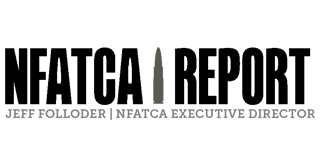JEFF FOLLODER | NFATCA EXECUTIVE DIRECTOR
Let us begin the following column content with a very direct statement: The NFATCA does not believe that suppressors (silencers) are firearms, nor should they be regulated as such. That said, suppressors currently are controlled by the National Firearms Act (NFA) and the Gun Control Act of 1968 (GCA) and variously implemented regulations. Unfortunately, having something that is heavily regulated often means that there will be those who seek to find ways around the laws. A firearm silencer and a firearm muffler are defined as “any device for silencing, muffling or diminishing the report of a portable firearm” (18 USC 921(a)(24)). The definition of a silencer also includes “any combination of parts, designed or redesigned, and intended for use in assembling or fabricating a firearm silencer or firearm muffler.” If you have been to a gun show or have been surfing firearms content online, you are undoubtedly aware of many outlets promoting various components as “solvent traps.” These parts and kits are designed to fit on the muzzle of a firearm and generally look like suppressor components, save for the fact that there is usually no drilled bore. And while these parts and kits are sold under the guise of a cleaning aid, there is a great deal of winking and nodding going on as to the real end-use of the parts and kits. Many sellers even go so far as to provide blank NFA Form 1’s for those customers who might want to turn their solvent trap into a legal suppressor. Wink. Nod.
In October 2019, Isaiah Goodwin of New Hampshire learned that a wink and a nod resulted in a great deal of personal duress. Mr. Goodwin pleaded guilty to Count 1 of an indictment that charged him with possession of a firearm silencer which was not registered to him in the National Firearms Registration and Transfer Record (NFRTR), in violation of 26 USC 5861(d). How did Goodwin get into this predicament? The Bureau of Alcohol, Tobacco, Firearms and Explosives (ATF) conducted an investigation of a manufacturer selling what it advertised as “solvent tubes” and “solvent cups” online. The ATF Firearms and Ammunition Technology Division determined that the so-called “solvent tubes” and “solvent cups” are in fact silencer parts, required to be registered in the NFRTR. Investigators received records from the manufacturer indicating that a customer using an email address assigned to the defendant and a mailing address of the defendant’s residence in Concord, New Hampshire, (the defendant) placed an order for one 10-inch D-Cell Solvent Tube (1 1/2 x 10 inches with solvent cups), which the ATF has classified as a firearm silencer part. Investigators located a Facebook post in which the defendant posted a photo of a firearm he was building and mentioned he was getting a “hush can,” a common term for a firearm silencer, for the firearm he was building.
Those various points provided enough bases for Goodwin to accept a plea of guilty. So, let’s unbundle those elements and add a dose of reality that is not misunderstood:
- The ATF is actively investigating manufacturers and sellers of these solvent traps.
- The ATF deems the solvent trap parts to actually be silencers when they are intended to be used as silencers.
- The ATF has convinced manufacturers (and presumably other retailers) to hand over their customer purchase records.
- The ATF is actively monitoring social media to bolster investigations and prosecutions.
It should be perfectly clear that not many folks, especially the folks at ATF, are buying the wink and nod related to solvent trap parts and kits. If you intend to use these items as a silencer, you need to lawfully register the items before you assemble and use them. If you are planning on skirting the law, you should know that ATF is investigating these items, obtaining customer purchase records and scouring social media for additional incriminating evidence. Now, given that professionally designed and assembled silencers tend to be safer and perform better than home-brewed concoctions, wouldn’t your effort be better spent on helping the NFATCA get silencers removed from the NFA? We want them gone, along with short-barreled rifles and short-barreled shotguns. As a matter of fact, we have a long list of action items that we continue to fight for on your behalf. Your continued support helps us keep fighting.
| This article first appeared in Small Arms Review V24N2 (Feb 2020) |












